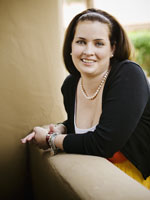Lisa Paige Kline

When actress Natasha Richardson died from an undiscovered brain injury after a skiing accident this year, I couldn’t stop thinking how lucky I am to be alive. Although my brain problem resulted from something I was born with and Richardson’s was from blunt head trauma, our stories could have ended the same way. Instead, I’m a healthy brain aneurysm survivor — four words that are rarely uttered together.
Six years ago, at age 27, I was partying with friends at a bar in Hollywood when I fell down and wasn’t able to get up. Thinking that I’d had a few too many drinks, my friends carried me out and took me home. No one knew that I had an aneurysm and that blood was already seeping around my brain—a condition that kills 40% of the 25,000 Americans who experience it every year.
An aneurysm occurs when an artery in the brain bulges way beyond its normal boundaries. If that bulge leaks or bursts, you’re at high risk of suffering severe brain damage or even death. Out of pure luck, I escaped the worst. Here’s my story.
Family to the rescue
I don’t remember much about the night my aneurysm started leaking, besides meeting some of the Los Angeles Lakers basketball players at the bar. The next night I was completely out of it and sleeping when the phone woke me. My father had just been rushed to the hospital. Soon my mom was knocking on the door and taking me to visit my dad—a trip that saved my life.
While watching the news in my father’s room, I started acting strangely: I heard that Arnold Schwarzenegger had been elected governor of California, but I didn’t remember that he was running. My mother thought I was still feeling the effects of my night out, but the doctor in the room sensed that something was wrong with me as I giggled loudly watching Schwarzenegger give a speech. And then I started throwing up.
The doctor told my family that I had either an aneurysm or meningitis, or had been given a date rape drug at the bar. Luckily, he sent me for an MRI. That’s when my family learned that I had an aneurysm near my brain stem that had leaked. Because it hadn’t burst, I didn’t need invasive brain surgery.
But I was “coiled”: A catheter (a small plastic tube) was inserted into the artery in my thigh, and, using X-ray guidance, tiny titanium coils were threaded through the catheter and into the aneurysm to block blood flow into it and prevent it from bleeding.
Reality sets in
For the next three weeks, I was in the hospital and could barely function while the doctors waited for my brain to heal around the coil and stop swelling. I was put on several drugs, including steroids, which caused me to gain a lot of weight in that short time.
My family, friends, and doctors had to keep explaining to me that I had an aneurysm and was OK, but I kept forgetting. I couldn’t even remember the horrible news that my father had terminal kidney cancer.
Finally out of the hospital, I started feeling the shock of what happened. The doctor explained that I had been living with an aneurysm that could have exploded in my head and caused massive damage.
Nearly 60% of aneurysm survivors suffer major disabilities. I was unbelievably lucky — they found it at the right time. If my father hadn’t been sick and my family hadn’t brought me to the hospital to see him, I could have died right there in my room, on my bed.
Had there been any hint of a problem?
Yes: I had spent years battling terrible headaches. But plenty of people have headaches, and my doctors thought they were caused by allergies or sinus problems.
It wasn’t until after my hospitalization that neurologist William Chow, MD, assistant clinical professor of medicine at the David Geffen School of Medicine at the University of California, Los Angeles, told me aneurysm sufferers often have headaches before the condition is diagnosed. I still get bad headaches, and it’s a smidgen more difficult to remember things, but I’m told the risk of another aneurysm is exceedingly small.
From trauma to triumph
I’m definitely a more cautious person today. The experience sobered me. You know The Bucket List, that 2007 movie about two patients who escape the cancer ward and jump out of an airplane for kicks? I might have considered that years ago. Not now.
Instead of focusing on thrills, I’m learning Braille and working hard to get into a physician’s assistant program. If I get a chance to help people the way I’ve been helped by others over the past five-plus years, that will be awesome.
Ultimately, I want the world to know that you can thrive after a serious brain injury. I’m proud to join the ranks of other aneurysm survivors — like Joe Biden, Quincy Jones, and Neil Young — who are leading full, happy lives.
